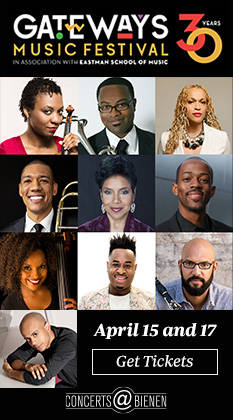Chicago Ensemble closes with a varied feast as Rush Hour opens 20th season

The seasonal slowdown on the local music beat has begun. But one wouldn’t know it Tuesday night, with one chamber group closing its season as another presenter opened its summer series. Fortunately congenial timing and geography made it possible to catch both.
The Rush Hour Concerts launched its 20th season of free hourlong programs at St. James Cathedral with Brahms’s Sextet No. 1. Performed by members of the Chicago Symphony (violinist Stephanie Jeong, violist Lawrence Neuman and cellist Brant Taylor) and Lyric Opera (violinist John Macfarlane, violist Carol Cook and cellist Calum Cook) orchestras, the program was dedicated to the memory of series founder, Deborah Sobol.
Written in 1860, Brahms’ Sextet in B-flat Major is the composer’s first chamber work for strings, predating his three quartets. Yet the 27-year-old composer’s mastery is manifest throughout in the seamless development and contrapuntal flair as well as the engaging blend of lyricism and rustic charm.
Things got off to an uneven start with unfocused violins in the expansive opening movement. Jeong’s first-chair solos sounded fitfully stiff and underprojected and there was a lack of grip and direction at times with tenuous moments at transition points.
Yet the playing became more cohesive and unified as the performance continued. Carol Cook’s burnished viola solos were consistently fine and Brant Taylor’s cello playing was glorious throughout, not least in the Andante’s variations and the finale, in which the easygoing grazioso quality was well rendered by the full ensemble.
Brahms’ score worked well in the vast cathedral’s tricky acoustic, lending an apt warmth and resonance to the string ensemble.
____________
Tuesday night’s main event was The Chicago Ensemble’s final program of its 42nd season at Fourth Presbyterian Church (to be repeated Sunday in Hyde Park). With four rarely heard works given robust and committed performances, the wide-roving lineup showed TCE founder Gerald Rizzer’s series at its very best.
Two works for piano and string quartet framed the program, leading off with Mozart’s Piano Concerto No. 12.
K. 414 was the most familiar music on the program, though Mozart’s concerto is usually heard in its orchestral guise, rather than the composer’s own reduction for piano and string quartet performed Tuesday. Little is lost musically in this version, especially when played with the idiomatic expression and intimacy of scale pianist Rizzer brought to this score.
Rizzer showed himself an inspired Mozartian in this confection, playing with a supple touch and firm rhythmic point. The pianist brought wistful expression to the Andante and the closing Rondeau was lovely with Rizzer phrasing with a nice blend of fantasy and charm. At times the string playing could have been more adroitly balanced but Rizzer’s colleagues (violinists Jaime Gorgojo and Alan Snow, violist Amy Hess and cellist Andrew Snow) provided fine support with lively give-and-take exchanges with the soloist.
Amid the sadly extensive roll-call of neglected 20th-century American composers, Walter Piston continues to rank high. Apart from the Grant Park Music Festival—which presented two of his symphonies in 2016 and 2018—Piston’s music remains rarely performed in Chicago. Indeed, today he is more often known as Leonard Bernstein’s teacher at Harvard than as an excellent composer in his own right.
Credit then to the Chicago Ensemble for presenting Piston’s Piano Quintet, which closed the evening. A prolific composer, Piston was a consummate craftsman as shown in this concentrated 1949 work.
Rizzer and colleagues delivered an inspired performance binging out Piston’s distinctive, somewhat elusive style. The stoic expression of the Adagio was conveyed as surely as the rugged syncopation and insistent energy of the outer movements.
Two oboe works proved welcome discoveries, both given terrific advocacy by Ricardo Castañeda.
Camille Saint-Saëns wrote several concise chamber works for winds at the end of his long life. Among these is his Oboe Sonata from 1921. While spanning just 11 minutes, the work is wholly characteristic in its craft and melodic inspiration.
Castañeda brought out the piquant charm of this petite gem. The oboist’s full, plangent tone, smooth line and breath control were most impressive in the Canteloube-like pastoral theme of the Allegretto and the brilliant arabesques of the final movement. Rizzer proved a simpatico keyboard partner.
Cast on a larger scale is Arthur Bliss’s Oboe Quintet (1927). Bliss’s individual music is a challenge to pigeonhole—neither part of the English pastoral school nor adopting the more experimental “ism’s” of the mid-20th century. Yet the music is attractive and written with skill and this work deserves to be much better known.
The oboe here is more primus inter pares and Castañeda again provided superb playing, bringing out the yearning and Gallic flavor of the opening movement as well as displaying fluent articulation in the motoric contrasting theme.
Castañeda and colleagues brought out the varied expression of the ensuing movements: relaxed rumination alternating with a faster dance-like motif in the middle movement, and an insistent main theme spiced by a touch of the English countryside in the gamboling oboe solo. The oboist brought mounting excitement and bravura to the finale with the string players—especially violinist Alan Snow—building up an equally daunting head of steam in the coda.
The Chicago Ensemble program will be repeated 3 p.m. Sunday at UC’s International House. thechicagoensemble.org
Rush Hour Concerts continue through August 13. The next concert is 5:45 p.m. June 11 at St. James Cathedral when the Gaudete Brass performs music of Raffaela Aleotti, Joan Tower, Stacy Garrop and Tania León. imfchicago.org
Posted in Performances






